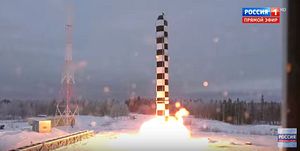Russia has upgraded facilities for the production of the super-heavy thermonuclear-armed RS-28 Sarmat (NATO designation: SS-X-29 Satan 2), Russia’s latest silo-based intercontinental-range ballistic missile (ICBM), Defense Minister Sergei Shoigu said during a speech in Russia’s Federation Council on March 25.
“The manufacturing facilities have been modernized in order to launch the serial production of the Sarmat heavy ICBM,” Shoigu was quoted as saying by TASS news agency on April 25.
The RS-28 is expected to slowly replace Soviet-era RS-36M2 Voyevoda (NATO designation: SS-18 Satan) ICBMs and has been designed to occupy the R-36M2 silos. As I reported in February, the first serial-produced RS-28 ICBM is slated to enter service in 2021.
A regiment of the Strategic Rocket Force’s 62nd Missile Division, deployed in Uzhur, part of the 33rd Guards Missile Army, headquartered in Omsk in southwestern Siberia, will reportedly be the first unit to receive the new ICBM. The regiment is slated to receive two ICBMs in 2021 with four more delivered in 2022.
Seven Sarmat ICBM regiments will reportedly be deployed and split up between two missile divisions based in Dombarovskiy near Yasny in Russia’s Orenburg Oblast, and Uzhur in Uzhursky District in Krasnoyarsk Krai. Six regiments will be each armed with six missiles, while one regiment is expected to receive 10 missiles for a total count of 46 ICBMs, according to Russian defense industry sources. Other defense sources have claimed that a total of twenty Strategic Rocket Force regiments could receive the new ICBM.
Shoigu in his March 25 remarks noted that modern equipment will constitute almost 90 percent of the inventory of the Russian Strategic Rocket Force by the end of 2020. “The proportion of modern equipment in service with the military is 68.2 percent and will reach 70 percent before the end of the year,” he said. “The level for the strategic nuclear forces will exceed 87 percent.”
The operational deployment of the RS-28, however, is already about three years behind schedule.
Earlier this year, I described the technical characteristics and purported capabilities of the new ICBM:
The RS-28 is reportedly housed in a modified 15P718M silo launching system. The maximum range of the RS-28 is 18,000 kilometers. With a launch weight of over 200 tons, it can carry up to 10 multiple independently targetable re-entry vehicles (MIRV), each carrying a thermonuclear warhead.
The RS-28, with a total length of 35.5 meters and a diameter of 3 meters, is also reportedly capable of carrying hypersonic weapons, according to Russian President Vladimir Putin.
Notably, Russia has not made public any flight tests of the new ICBM. The last publicly announced test was an ejection of the Sarmat in May 2018. Two other ejection tests took place in March 2018 and December 2017. These tests involved the ignition of the ICBM’s first stage and booster engine. No flight test of the ICBMs second- and third-stage engines have been announced.































